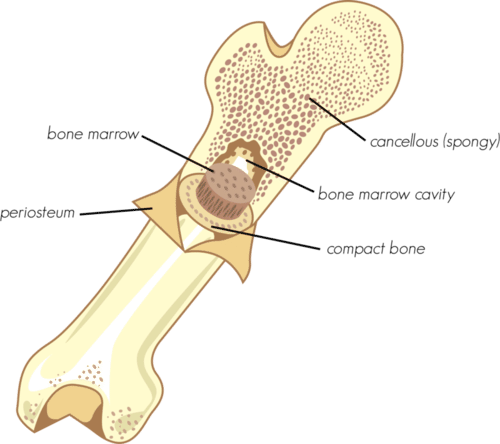13.44: Bones
- Page ID
- 1397
\( \newcommand{\vecs}[1]{\overset { \scriptstyle \rightharpoonup} {\mathbf{#1}} } \)
\( \newcommand{\vecd}[1]{\overset{-\!-\!\rightharpoonup}{\vphantom{a}\smash {#1}}} \)
\( \newcommand{\dsum}{\displaystyle\sum\limits} \)
\( \newcommand{\dint}{\displaystyle\int\limits} \)
\( \newcommand{\dlim}{\displaystyle\lim\limits} \)
\( \newcommand{\id}{\mathrm{id}}\) \( \newcommand{\Span}{\mathrm{span}}\)
( \newcommand{\kernel}{\mathrm{null}\,}\) \( \newcommand{\range}{\mathrm{range}\,}\)
\( \newcommand{\RealPart}{\mathrm{Re}}\) \( \newcommand{\ImaginaryPart}{\mathrm{Im}}\)
\( \newcommand{\Argument}{\mathrm{Arg}}\) \( \newcommand{\norm}[1]{\| #1 \|}\)
\( \newcommand{\inner}[2]{\langle #1, #2 \rangle}\)
\( \newcommand{\Span}{\mathrm{span}}\)
\( \newcommand{\id}{\mathrm{id}}\)
\( \newcommand{\Span}{\mathrm{span}}\)
\( \newcommand{\kernel}{\mathrm{null}\,}\)
\( \newcommand{\range}{\mathrm{range}\,}\)
\( \newcommand{\RealPart}{\mathrm{Re}}\)
\( \newcommand{\ImaginaryPart}{\mathrm{Im}}\)
\( \newcommand{\Argument}{\mathrm{Arg}}\)
\( \newcommand{\norm}[1]{\| #1 \|}\)
\( \newcommand{\inner}[2]{\langle #1, #2 \rangle}\)
\( \newcommand{\Span}{\mathrm{span}}\) \( \newcommand{\AA}{\unicode[.8,0]{x212B}}\)
\( \newcommand{\vectorA}[1]{\vec{#1}} % arrow\)
\( \newcommand{\vectorAt}[1]{\vec{\text{#1}}} % arrow\)
\( \newcommand{\vectorB}[1]{\overset { \scriptstyle \rightharpoonup} {\mathbf{#1}} } \)
\( \newcommand{\vectorC}[1]{\textbf{#1}} \)
\( \newcommand{\vectorD}[1]{\overrightarrow{#1}} \)
\( \newcommand{\vectorDt}[1]{\overrightarrow{\text{#1}}} \)
\( \newcommand{\vectE}[1]{\overset{-\!-\!\rightharpoonup}{\vphantom{a}\smash{\mathbf {#1}}}} \)
\( \newcommand{\vecs}[1]{\overset { \scriptstyle \rightharpoonup} {\mathbf{#1}} } \)
\( \newcommand{\vecd}[1]{\overset{-\!-\!\rightharpoonup}{\vphantom{a}\smash {#1}}} \)
\(\newcommand{\avec}{\mathbf a}\) \(\newcommand{\bvec}{\mathbf b}\) \(\newcommand{\cvec}{\mathbf c}\) \(\newcommand{\dvec}{\mathbf d}\) \(\newcommand{\dtil}{\widetilde{\mathbf d}}\) \(\newcommand{\evec}{\mathbf e}\) \(\newcommand{\fvec}{\mathbf f}\) \(\newcommand{\nvec}{\mathbf n}\) \(\newcommand{\pvec}{\mathbf p}\) \(\newcommand{\qvec}{\mathbf q}\) \(\newcommand{\svec}{\mathbf s}\) \(\newcommand{\tvec}{\mathbf t}\) \(\newcommand{\uvec}{\mathbf u}\) \(\newcommand{\vvec}{\mathbf v}\) \(\newcommand{\wvec}{\mathbf w}\) \(\newcommand{\xvec}{\mathbf x}\) \(\newcommand{\yvec}{\mathbf y}\) \(\newcommand{\zvec}{\mathbf z}\) \(\newcommand{\rvec}{\mathbf r}\) \(\newcommand{\mvec}{\mathbf m}\) \(\newcommand{\zerovec}{\mathbf 0}\) \(\newcommand{\onevec}{\mathbf 1}\) \(\newcommand{\real}{\mathbb R}\) \(\newcommand{\twovec}[2]{\left[\begin{array}{r}#1 \\ #2 \end{array}\right]}\) \(\newcommand{\ctwovec}[2]{\left[\begin{array}{c}#1 \\ #2 \end{array}\right]}\) \(\newcommand{\threevec}[3]{\left[\begin{array}{r}#1 \\ #2 \\ #3 \end{array}\right]}\) \(\newcommand{\cthreevec}[3]{\left[\begin{array}{c}#1 \\ #2 \\ #3 \end{array}\right]}\) \(\newcommand{\fourvec}[4]{\left[\begin{array}{r}#1 \\ #2 \\ #3 \\ #4 \end{array}\right]}\) \(\newcommand{\cfourvec}[4]{\left[\begin{array}{c}#1 \\ #2 \\ #3 \\ #4 \end{array}\right]}\) \(\newcommand{\fivevec}[5]{\left[\begin{array}{r}#1 \\ #2 \\ #3 \\ #4 \\ #5 \\ \end{array}\right]}\) \(\newcommand{\cfivevec}[5]{\left[\begin{array}{c}#1 \\ #2 \\ #3 \\ #4 \\ #5 \\ \end{array}\right]}\) \(\newcommand{\mattwo}[4]{\left[\begin{array}{rr}#1 \amp #2 \\ #3 \amp #4 \\ \end{array}\right]}\) \(\newcommand{\laspan}[1]{\text{Span}\{#1\}}\) \(\newcommand{\bcal}{\cal B}\) \(\newcommand{\ccal}{\cal C}\) \(\newcommand{\scal}{\cal S}\) \(\newcommand{\wcal}{\cal W}\) \(\newcommand{\ecal}{\cal E}\) \(\newcommand{\coords}[2]{\left\{#1\right\}_{#2}}\) \(\newcommand{\gray}[1]{\color{gray}{#1}}\) \(\newcommand{\lgray}[1]{\color{lightgray}{#1}}\) \(\newcommand{\rank}{\operatorname{rank}}\) \(\newcommand{\row}{\text{Row}}\) \(\newcommand{\col}{\text{Col}}\) \(\renewcommand{\row}{\text{Row}}\) \(\newcommand{\nul}{\text{Nul}}\) \(\newcommand{\var}{\text{Var}}\) \(\newcommand{\corr}{\text{corr}}\) \(\newcommand{\len}[1]{\left|#1\right|}\) \(\newcommand{\bbar}{\overline{\bvec}}\) \(\newcommand{\bhat}{\widehat{\bvec}}\) \(\newcommand{\bperp}{\bvec^\perp}\) \(\newcommand{\xhat}{\widehat{\xvec}}\) \(\newcommand{\vhat}{\widehat{\vvec}}\) \(\newcommand{\uhat}{\widehat{\uvec}}\) \(\newcommand{\what}{\widehat{\wvec}}\) \(\newcommand{\Sighat}{\widehat{\Sigma}}\) \(\newcommand{\lt}{<}\) \(\newcommand{\gt}{>}\) \(\newcommand{\amp}{&}\) \(\definecolor{fillinmathshade}{gray}{0.9}\)
Are bones living?
It's common to think of bones as not living. But bones are very much living. In fact, you are constantly making new bone tissue. That means that you are also constantly getting rid of bone. Bone is full of blood and nerves and all sorts of cells and proteins, making it an extremely complex living tissue.
Structure of Bones
Many people think of bones as being dead, dry, and brittle. These adjectives correctly describe the bones of a preserved skeleton, but the bones in a living human being are very much alive. As shown in Figure below, the basic structure of bones is bone matrix, which makes up the underlying rigid framework of bones, composed of both compact bone and spongy bone. The bone matrix consists of tough protein fibers, mainly collagen, that become hard and rigid due to mineralization with calcium crystals. Bone matrix is crisscrossed by blood vessels and nerves and also contains specialized bone cells that are actively involved in metabolic processes.
 Bone matrix provides bones with their basic structure. Notice the spongy bone in the middle, and the compact bone towards the outer region. The osteon is the functional unit of compact bone.
Bone matrix provides bones with their basic structure. Notice the spongy bone in the middle, and the compact bone towards the outer region. The osteon is the functional unit of compact bone.Bone Cells
There are three types of specialized cells in human bones: osteoblasts, osteocytes, and osteoclasts. These cells are responsible for bone growth and mineral homeostasis.
- Osteoblasts make new bone cells and secrete collagen that mineralizes to become bone matrix. They are responsible for bone growth and the uptake of minerals from the blood.
- Osteocytes regulate mineral homeostasis. They direct the uptake of minerals from the blood and the release of minerals back into the blood as needed.
- Osteoclasts dissolve minerals in bone matrix and release them back into the blood.
Bones are far from static, or unchanging. Instead, they are dynamic, living tissues that are constantly being reshaped. Under the direction of osteocytes, osteoblasts continuously build up bone, while osteoclasts continuously break it down.
Bone Tissues
Bones consist of different types of tissue, including compact bone, spongy bone, bone marrow, and periosteum. All of these tissue types are shown in Figure below.
- Compact bone makes up the dense outer layer of bone. Its functional unit is the osteon. Compact bone is very hard and strong.
- Spongy bone is found inside bones and is lighter and less dense than compact bone. This is because spongy bone is porous.
- Bone marrow is a soft connective tissue that produces blood cells. It is found inside the pores of spongy bone.
- Periosteum is a tough, fibrous membrane that covers and protects the outer surfaces of bone.
 This bone contains different types of bone tissue. How does each type of tissue contribute to the functions of bone?
This bone contains different types of bone tissue. How does each type of tissue contribute to the functions of bone?Summary
- Under the direction of osteocytes, osteoblasts continuously build up bone, while osteoclasts continuously break down bone. These processes help maintain mineral homeostasis.
- Bone tissues include compact bone, spongy bone, bone marrow, and periosteum.
Review
- Describe bone matrix.
- Identify the three types of specialized bone cells and what they do.
- Compare and contrast the structure and function of compact bone and spongy bone.
- What is bone marrow? Where is it found?
| Image | Reference | Attributions |
 |
[Figure 1] | License: CC BY-NC |
 |
[Figure 2] | Credit: Courtesy of U.S. National Cancer Institute's Surveillance, Epidemiology and End Results (SEER) Program, modified by Marianna Ruiz Villarreal (User:LadyofHats/Wikimedia Commons) for CK-12 Foundation Source: commons.wikimedia.org/wiki/File:Illu_compact_spongy_bone.jpg License: Public Domain |
 |
[Figure 3] | Credit: Christopher Auyeung Source: CK-12 Foundation License: CC BY-NC 3.0 |

